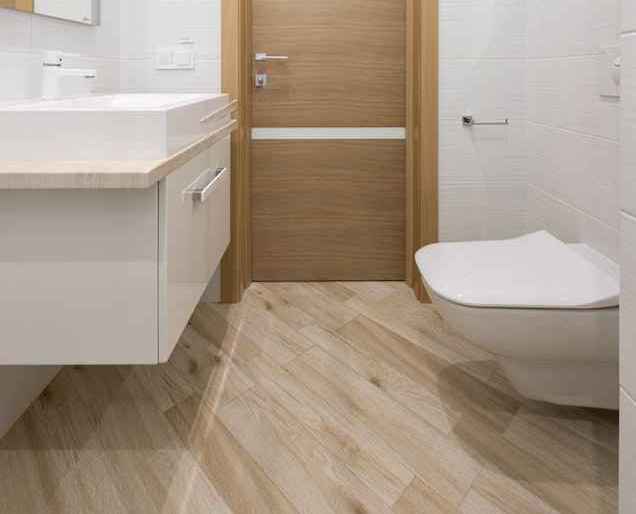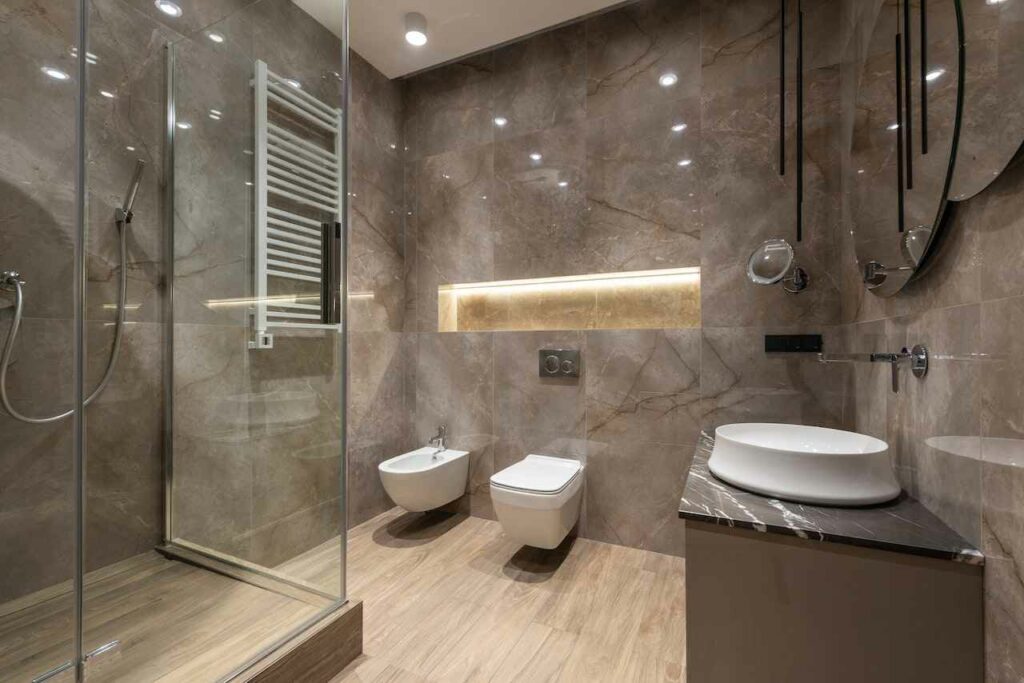Yes, you can use laminate flooring in a bathroom, especially in half baths and small toilets, as it is water-resistant and durable.
However, installing an underlay to protect it from moisture in the subfloor and using a sealant to avoid water damage is crucial.
Laminate flooring is not ideal for bathrooms with a lot of splashing, such as those used by toddlers during bath time.
In such cases, there are better flooring choices available.
Laminate floors that lock into place are not ideal for a bathroom because water can seep through.
It is recommended to use a waterproof silicone caulk when installing laminate to add another layer of protection against water and humidity.
What Type Of Underlay Should Be Used When Installing Laminate Flooring In A Bathroom?

When installing laminate flooring in a bathroom, it is important to choose the right underlayment.
Several types of underlayment can be used, including foam, cork, plywood, hardboard, and cement board.
Cork is a premium underlayment for laminate flooring as it is used to reduce noise and has natural antimicrobial properties that prevent mold growth between the laminate flooring and the subfloor.
However, cork can be expensive and add up to 50% to the cost of laminate flooring installation.
Foam underlayment is a more affordable option that can provide cushioning and help the laminate planks lay smoother and connect better.
Can You Recommend Any Specific Sealant Products Suitable For Protecting Laminate Flooring In A Bathroom?
Several sealant products can be used to protect laminate flooring in a bathroom.
Here are some options:
- Ronseal Laminate Floor Seal is a quick and easy-to-use spray that restores shine and protects against daily wear and tear.
- Slip Doctors Floor Grip is a water-based urethane sealer that can be rolled onto laminate to create a non-slip coating.
- 100% silicone caulk can be used to fill expansion gaps at the walls and fixtures to prevent moisture problems and water from soaking into the laminate core.
- Polyurethane coating or a clear coat can seal the entire laminate floor. Still, it is essential to check with the manufacturer first to ensure compatibility and avoid damage to the flooring.
What Are Some Alternative Flooring Options For Bathrooms With A Lot Of Splashing Or High Humidity?
There are several alternative flooring options for bathrooms with high humidity or splashing:
- Glass floor tile, glass block, and glass mosaic are upscale and unique options that are resistant to moisture, stains, mold, and mildew
- Vinyl, linoleum, and rubber flooring are durable and water-resistant options that can withstand high humidity and splash
- Concrete flooring is a modern and stylish option that is also water-resistant
- Cork flooring is a sustainable and water-resistant option that is also soft and comfortable underfoot
- Porcelain or ceramic tile with a slip-resistant finish is a classic and practical option for bathroom flooring
Are There Any Specific Precautions Or Maintenance Practices That Should Be Followed To Ensure The Longevity Of Laminate Flooring In A Bathroom?
Yes, there are specific precautions and maintenance practices that should be followed to ensure the longevity of laminate flooring in a bathroom.
Laminate floors are not recommended for areas that may experience standing water, such as bathrooms or utility rooms.
However, if you choose to install laminate flooring in your bathroom, you should follow these precautions and maintenance practices:
- Vacuum or dust mop as needed
- Use a gentle cleanser to spot-clean visibly dirty areas, and always follow up by wiping the area with a dry, absorbent cloth
- Avoid using excess moisture when cleaning, as it can lead to warping and damage
- After cleaning, always make sure to thoroughly dry the floor using a soft, clean towel or a microfiber mop
- Do not allow standing water, as it can seep into the seams and cause swelling
Can You Explain The Process Of Applying Waterproof Silicone Caulk When Installing Laminate Flooring In A Bathroom?
To apply waterproof silicone caulk when installing laminate flooring in a bathroom, follow these steps:
- Use AC3-rated laminate flooring and leave 1/4-inch expansion gaps at the walls and fixtures.
- Fill the gaps at the flooring ends with 100 percent silicone caulk.
- Use a caulk gun to apply the silicone caulk.
- Wipe away any excess caulk with a rag.
- Use more silicone caulk than you think you’ll need.
- Allow the caulk to dry completely before walking on the floor.
It is important to use waterproof silicone caulk when installing laminate flooring in a bathroom to prevent water damage and buckling of the floor.







